|
Interview
with Rueben Garbanzo from FOCW
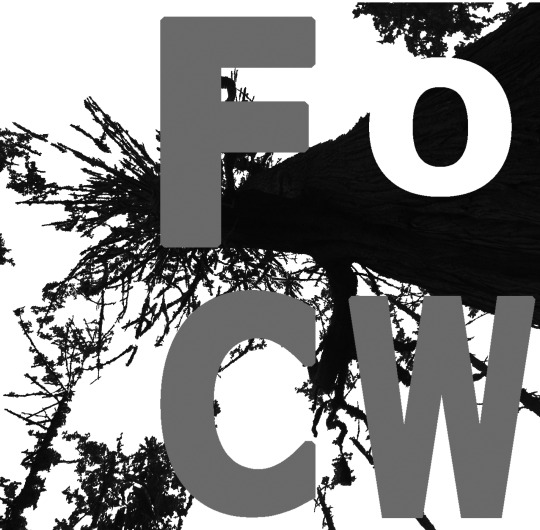
Who
are the Friends of Carmanah/ Walbran?
RG: We are a small, 100% volunteer, multi-generational
collective of concerned citizens from a broad cross-section of
society, who work for the protection of the endangered ancient
temperate rainforests of the Walbran Valley, unceded
Pacheedaht/Qwa-ba-diwa territory, 3.5 hours drive from
Victoria B.C (Lekwungen territory), upstream from the fabled
West Coast Trail, Pacific Rim National Park and about 35
kilometres northeast of Port Renfrew.
We advocate for economic alternatives to continued logging of
the last five percent of the remaining low-elevation
old-growth forests on south Vancouver Island, contained within
the Carmanah/Walbran rainforest - that would also benefit
local forest-dependent and First Nations communities. These
alternatives include labour-intensive, job-producing
ecological management of second-growth forests, small cottage
industries harvesting non-timber forest products and both
First Nations ethnocultural and eco-tourism.
We are dedicated to developing recreational infrastructure to
provide public access to the area e.g. hiking trails,
boardwalk construction, campsite and interpretive facilities
in threatened rainforests adjacent to Carmanah/ Walbran
Provincial Park - whatever gets people out there to enjoy and
help protect this outstanding environment!!!
We attempt to raise public awareness of the natural beauty of
the forest and logging threats to the ecological integrity of
the watershed. We build ties with members of the Pacheedaht
and Qwa-ba-diwa First Nations in whose ancestral territory the
Walbran Valley (Ka:xics - meaning Big River in Pacheedaht) is
located. We support and publicize on-going scientific research
into the threatened geology and ecology of the area. We host
the Facebook page, Walbran Central and the Friends of
Carmanah/Walbran Community FB page and the
Friends of Carmanah Walbran website. We also hold
regular educational events and rallies.
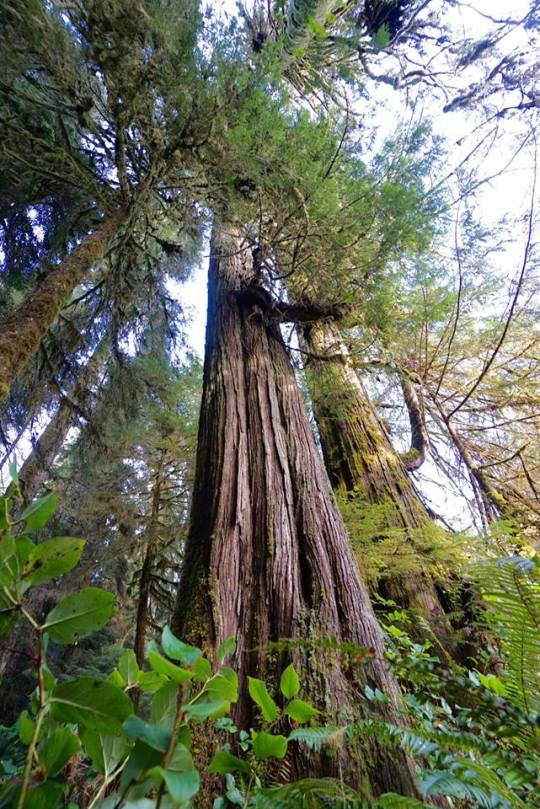
Our
roots as a group extend back into the 90’s when we were
organizing direct action during the Road Stops Here
campaign, in which individuals acting independently out of
their own freedom of conscience engaged in sustained and
creative road blockades, tree-sits and other forms of work
slowdowns, which prevented the construction of almost 15
kilometres of road-building in the summer of 1991.
At the moment, our focus is gaining protection for a 485
hectare area of contiguous ancient forest north-west of
Walbran river, along the boundaries of Carmanah/Walbran
Provincial Park, in the heart of the watershed. And to call
for a moratorium on logging and road-building activities in a
1600 hectare buffer zone around the park, in an area known as
Special Management Zone 21, which under the Vancouver
Island Land Use Plan, is supposed to integrate forestry,
biodiversity, recreational viewscapes and retention of
outstanding old-growth forest values. It is the position of
our group that the current old-growth logging in this area is
inappropriate and should be halted, pending a broad community
consultation process that comes up with a better plan for the
protection of all the non-timber values associated with this
rare and non-renewable ancient forest.

The
Carmanah Walbran Valley has a history of uprising against
commercial logging dating back to the 80's and 90's, which
you were involved in. How did that come about and how were
you able to get the Provincial government to buy back the
tree licences from Macmillan Bloedell?
RG: Well, the whole ancient forest movement on the south
island anyways, was kick-started by a lone hiker, the late
Randy Stoltmann, who worked with the Western Canada Wilderness
Committee (WCWC) and who was the first white guy to lay eyes
on what is still the tallest recorded tree in Canada - the
Carmanah Giant, a spectacular Sitka Spruce (Picea sitchensis)
in the Lower Carmanah Valley, in an area that was being
actively logged in the mid-80s. WCWC led a very effective
public awareness campaign that was supported by its
trail-building work from the headwater of the watershed to
just inside the river mouth, unveiling some of the most
exquisitely beautiful living cathedrals of iconic ancient
forest environments seen anywhere on Vancouver island or the
world; and which allowed the public to see an entirely
unlogged watershed slated for the same kind of colossal
clearcut destruction that at the time had decimated most of
the area outside Carmanah and it's lesser known neighbouring
watershed to the south, the Wallbran Valley.
This marked the beginning of a high level of public engagement
around the protection of these disappearing forests. Soon
afterwards, a trail-building campaign started in the Walbran
Valley. What that giant Sitka Spruce was to Carmanah, giant
Western red cedars were to the Walbran. Whereas Carmanah had
the tranquil, lush alluvial river flats for meandering in awe
under the giant spruces, over the ridges the Walbran had a
more rugged landscape of waterfalls, remote lakes and emerald
pools amid steeper, rockier terrain and a lot of karst
limestone formations. Everyone who has been to either valley,
will say the same thing: It cannot be logged. It is not for
sale. It is simply too sacred! When a largely settler movement
with a significantly weaker sense of place in relationship to
the land than indigenous culture has had for literally aeons,
comes so unanimously to the same conclusion as more and more
people have about the cutting of these forest cathedrals,
there is something very powerfully correct about people taking
this kind of stand.
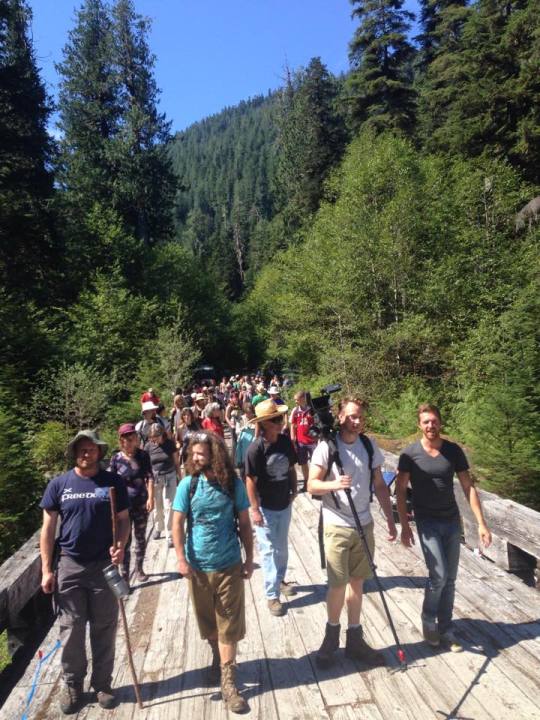
As I mentioned, in the summer of 1991, two transnational
logging companies with timber licenses to clearcut all of the
Walbran Valley, Macmillan-Bloedel (TFL 44) and (in TFL 46)
New-Zealand based Fletcher Challenge (who had incidentally
been forced to invest in logging old-growth in Canada after
the ancient Kaori forests in New Zealand were entirely
protected by a ban on all old-growth logging) had been
approved to punch sixteen kilometres of logging roads through
the entire watershed, including over forests which had public
witness trails built through them.
International forest activists joined local citizens at the
bridge over Walbran river to take a stand of peaceful direct
actions against these road incursions and after a sustained
stand-off lasting 78 consecutive days and dozens of arrests,
only three kilometres of roads had been built. With pressure
growing to stop the destruction, the IWA locals representing
forest workers in Duncan, Port Alberni and Port Renfrew met
with reps from the ENGO community, including Friends of
Carmanah/Walbran (I was there) for a twelve hour meeting over
BBQ chicken that resulted in the South Island Forest Accord,
which explicitly acknowledged that it was corporate greed of
the major logging companies liquidating the last of the "green
gold" in the ancient forests and poor forest management:
overcuttting, mechanization and raw log exports for the
maximization of shareholders' profits, that was the primary
cause of both deforestation and job loss in local industry
towns. It was agreed, put more positively, that if the
resource were managed more sustainably for the interests of
the communities, human and nonhuman, directly depending on
them, that there could be large tracts of old-growth forest
set aside in parkland, with no job loss.
This agreement became the template for the NDP Peace in
the Woods platform in the 1992 provincial elections, an
election they won. Shortly after that, the new government
struck the Commission on Resources and Environment (CORE), a
multi-stakeholder roundtable negotiations to look at how to
implement a plan to protect a minimum of 12% of representative
ecosystems in a protected areas strategy. As a result of this
process, the Vancouver Island Land Use Plan came to be as the
guiding document in the drafting of the park boundaries in the
creation of the 16,000 hectare Carmanah/Walbran Provincial
Park in 1994.

All
of Carmanah valley was saved (adding the upper watershed to
the lower valley around the Carmanah Giant, that had already
been protected by the former SoCred government) and roughly
half the Walbran watershed. And two smaller watersheds with
low timber values, less than 3500 hectares south of the
Walbran, were protected.
The experience of the conservation sector sitting around the
table at the time, was that the timber industry had stacked
the process and that there was not adequate representation of
the low-elevation ancient temperate rainforests offered up for
park protection. Indeed the most contentious and many people
argue amongst the most beautiful and, to this day, most
recreationally used area, around the the waterfall in the
Central Walbran, hydrologically the heart of the valley,
containing significant stands of some of the largest and
oldest standing Western red-cedar trees in the world in the
Castle Grove, with one tree aged at approximately 1200 years
old, was left on the chopping block, to the satisfaction of
the timber interests bearing heavy influence on the decision.
This area, left outside the park, was designated for
restrictive forest harvesting in a 1600 buffer zone, known as
Special Management Zone 21 where logging could continue but
with protection of the outstanding old-growth forest,
biodiversity and recreational values.
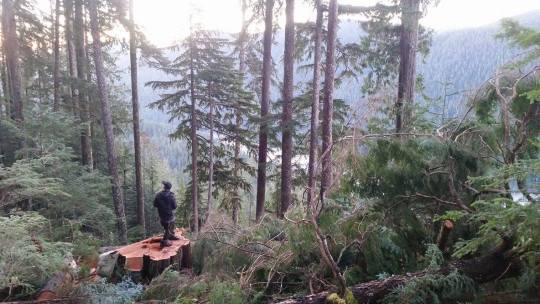
Did
this set a precedent for future protests?
RG: What was widely perceived as an inappropriate park
boundary and an area of contiguous ancient temperate
rainforest people had taken a serious stand to protect, but
still subject to the demands of resource extraction, was the
seed for the current conflict in the Walbran valley.
Forest activists like myself vowed that if ever the industry
were to cross the river and try and open up logging on the
northwest side of the river, they would be met with
resistance.
After twenty-five years of calm in the pristine remnants of
unprotected ancient forest in the Central Walbran valley,
across the bridge on the northwest side of Walbran river, a
new licensee, Surrey-based forest products company Teal Jones,
submitted a logging plan for eight cutblocks in the area, an
action likened to someone pushing a big stick into the center
of a hornet's nest, prompting a massive public backlash
reminiscent of the early 90s.
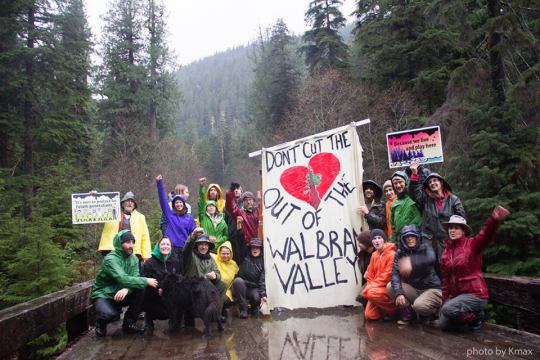
What's
going on now ahy should people care?
RG: In September of this year the government gave approval for
the first of the company's proposed eight cutblocks and the
Friends of Carmanah/Walbran established a "witness camp" at
Walbran bridge to maintain a steady vigil against these
logging plans and to monitor the daily logging developments on
the ground and communicate back to activists outside of the
valley via satellite phone. At this time, heavy industrial
logging and road-building, blasting and helicopter logging
operations have advanced aggressively to the park boundaries,
within the designated buffer/ SMZ area. Activists, responding
to the daily assaults on old-growth forest ecosystems in the
area, have taken it upon themselves to engage in independent
direct action, blocking road-building crews, tree falling and
log trucks for days on end, in breach of several court orders
sought by the company to stifle land-based dissent, but which
to date have not been enforced by the RCMP.
At stake is a rare, irreplaceable world-class remnant of one
of the most biologically productive ecosystems in the world,
containing more plant biomass than anywhere else on earth,
worth far more standing as critical habitat for the many
species that depend exclusively on large tracts of old-growth
forests for their continued survival, as a critical carbon
sink helping to mitigate against runaway climate change. And
for it's outstanding long-term recreational and tourism
values, rather than as short-term profit on the global shake
and shingles market.

How
were Teal Jones able to get tree farm licenses in the
Valley? Is it true that they were giving political donations
to various parties?
RG: In 1954, in exchange for a $10,000 bribe from Western
Forest Products, Forest Minister "Honest" Bob Sommers granted
the first timber license, introducing the current forest
tenure system in BC. Without any consultation or consent from
First Nations, companies purchase cutting rights to vast
tracts of forestland, can extract original forests in exchange
for stumpage fees, incidentally the lowest in the
industrialized world and a commitment to replant; converting
biologically-diverse, multi-aged, multi-layered, mixed-species
natural forests that have evolved relatively undisturbed since
the retreat of the last ice sheets into monoculture tree
plantations with very little value for habitat and producing a
far inferior quality of wood than the primary forests they
replace.

Over time, stipulations under the TFL agreement that required
the licensees to supply mills with timber and to maintain
community stability have been removed by free market
governments like the current Liberal regime, to facilitate
greater corporate profits by exporting raw logs out of the
country and cutting union labour out of the chain of
production.
Teal Jones is merely one of a long line of licensees in TFL 46
and is actually one company, which to its credit, that mills
wood here in BC. They, like many big businesses, contribute to
the campaign coffers of both the Liberal and NDP party, to
make sure that they receive political patronage and support
from government. Unfortunately, the Friends of
Carmanah/Walbran don't have such coffers accrued through
exploitation of public resources, to ensure we will have the
government's ear when we need their help to protect the forest
for the benefit of all, not just the corporate interest.

I
wanted to ask more about Indigenous involvement currently.
Are "divide and conquer" tactics used in First Nations
communities by logging companies (as mining companies do in
impoverished Aboriginal communities in Australia)? And who
is Peter Knighton?
I would have to say in all honesty that I am not in a position
to comment on or make judgments about issues that are being
dealt with internally by the First Nations communities in the
Walbran valley.
I do know that the area is considered part of the Pacheedaht
unceded traditional territory and that the band council
definitely has strong ties with Teal Jones and are themselves
very involved in the business of industrial logging, with
their own company, Queesto, that has a Tree Farm License on
the West Coast Rd. and logging operations contracted to them
adjacent to Carmanah/ Walbran Provincial Park in TFL 44; and
plans to build their own mill.
With any kind of development, you always have to ask the three
basic questions: Who decides, who benefits and who is most
impacted. As far as I know, these questions are being asked by
some Pacheedaht members, as much as they are anywhere else and
straight answers, like anywhere else, are not always
forthcoming!
Old- growth logging has been pursued by band leaders,as a form
of much- needed economic development in a community facing
chronic financial poverty. These plans and particularly the
band council's support for Teal Jones logging in contentious
areas in the Walbran valley, in exchange for a promised supply
of monumental cedars sourced from the slopes of Walbran river,
has stirred up some controversy in the community, and like in
any community, those issues will be dealt with to varying
degrees of satisfaction by the members involved. All that
said, Pacheedaht elder Bill Jones has been an outspoken
advocate for the forest, himself visiting the witness camp and
participating in land- based protests and requesting a hunting
cabin be built in his name in the Central Walbran, which I
understand the band turned down. To what extent he is
supported in his community, I don't really know.

Peter Knighton who is the brother of the hereditary chief of
the Qwa-ba-diwa First Nations, whose village, before the
forced relocation of coastal indigenous peoples onto reserves,
was located at the mouth of Carmanah river. Peter and his
wife, Monique, live there spring through autumn, within
Pacific Rim National Park, which was created on their
territory. He has asserted traditional jurisdiction, never
ceded, which therefore gives them the right to re-occupy the
village site and to sell supplies to back- packers on the West
Coast trail. Peter is a longstanding friend of many of the
older members of FOCW and is a strong advocate of protection
of the temperate rainforests in his ancestral territory, which
does include the Walbran valley.
FOCW is supportive of a conservation land designation in the
Walbran Valley akin to the Tla-o-qui-aht Tribal Parks in
Clayoquot Sound, that enshrines traditional First Nations
jurisdiction and allows economic development that protects the
forest-base e.g. tourism, harvesting of non-timber resources,
non-industrial logging etc. in which there are long-term
benefits to the community, unlike the boom/ bust cycle of
clearcut logging that liquidates forest resources, leaving
little for local communities.
What are some of the different ways people an help out with
the campaign?
RG:People need to figure that kind of stuff out for
themselves, really. Being committed to getting informed is a
minimum first step and prerequisite of citizenship. Then
making a point of making your views known to your elected
officials is another necessary action to take. Democracy works
best on the basis of consciously removing your consent for
those policies you cannot fundamentally agree with and by
advocating for alternatives that are better for people and
planet. If you have money, make donations. If you have a
skill, share it. If you have an extra wood stove, share that!
If you have time, give of yourself by attending rallies or
building trails or painting signs or organizing an event in
the community or writing posts in online blogs, social media
sites or letters to the editor. Just get engaged wherever you
feel you can most passionately express yourself and remember
the words of the prophet who said that anyone who thinks they
are too small to make a difference, never slept in a room with
a mosquito! We are all part of something bigger than
ourselves. The community of kindred souls is amazing! Find
your voice and play your part and don't give up. Another great
saying is: at first they ignore you, then they curse you, then
they fight you, then they jail you, and then you win!

What
are your thoughts on civil disobedience?
RG: In society there is a continual gap between the law and
what is truly just, equitable and ecologically sustainable and
so civil disobedience is a necessary function of both
democracy and of the evolution of law. It is a time-honoured
and noble tradition around the world and is an effective
tactic in gaining public attention to issues systemically
ignored, and for pushing social crises' to the point of
resolution. Like any other power tool, it needs to used
responsibly and as a last resort when all legal avenues have
been exhausted and citizens have no other recourse to address
an injustice. It often produces positive results and was a
central part of the massive public campaign gaining protection
for the 16,000 hectare Carmanah/Walbran Provincial Park in the
early 1990s.
http://friendsofcarmanahwalbran.com
*This is an old interview (from 2015, I think). I didn't take
any of these photos and don't remember where I got them from
so let me know if one of them is yours and I'll credit you :)
**The latest campaign: https://laststandforforests.com/


|













